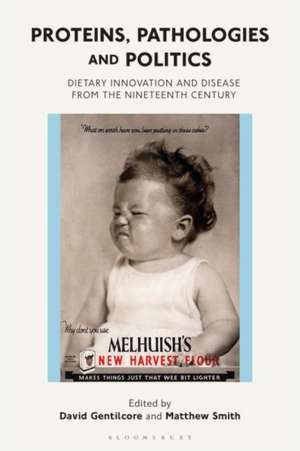Proteins, Pathologies and Politics: Dietary Innovation and Disease from the Nineteenth Century
Editat de Professor David Gentilcore, Dr Matthew Smithen Limba Engleză Paperback – 24 iun 2020
| Toate formatele și edițiile | Preț | Express |
|---|---|---|
| Paperback (1) | 224.76 lei 43-57 zile | |
| Bloomsbury Publishing – 24 iun 2020 | 224.76 lei 43-57 zile | |
| Hardback (1) | 652.40 lei 43-57 zile | |
| Bloomsbury Publishing – 12 dec 2018 | 652.40 lei 43-57 zile |
Preț: 224.76 lei
Preț vechi: 288.89 lei
-22% Nou
Puncte Express: 337
Preț estimativ în valută:
43.01€ • 45.02$ • 35.80£
43.01€ • 45.02$ • 35.80£
Carte tipărită la comandă
Livrare economică 31 martie-14 aprilie
Preluare comenzi: 021 569.72.76
Specificații
ISBN-13: 9781350170209
ISBN-10: 1350170208
Pagini: 264
Ilustrații: 15 bw illus
Dimensiuni: 156 x 234 x 22 mm
Greutate: 0.37 kg
Editura: Bloomsbury Publishing
Colecția Bloomsbury Academic
Locul publicării:London, United Kingdom
ISBN-10: 1350170208
Pagini: 264
Ilustrații: 15 bw illus
Dimensiuni: 156 x 234 x 22 mm
Greutate: 0.37 kg
Editura: Bloomsbury Publishing
Colecția Bloomsbury Academic
Locul publicării:London, United Kingdom
Caracteristici
David Gentilcore is a very well-respected Professor of History, and Matthew Smith's previous work has had appeal within and also beyond the academy and was reviewed by the New York times
Notă biografică
David Gentilcore is Professor of Early Modern History at the University of Leicester, UK. He is the author of Pomodoro! (2010) and Medical Charlatanism in Early Modern Italy (2006).Matthew Smith is Professor of Health History at the University of Strathclyde's Centre for the Social History of Health and Healthcare, UK. He is the author of An Alternative History of Hyperactivity (2011), Hyperactive (2012) and Another Person's Poison (2015).
Cuprins
List of IllustrationsIntroductionDavid Gentilcore, (University of Leicester, UK) and Matthew Smith, (University of Strathclyde, UK)Part One: Responding to Chronic Disease1. The Pre-History of the Paleo Diet: Cancer in Nineteenth-Century Britain, Agnes Arnold-Forster, (Kings College London, UK)2. Nutrition, Starvation and Diabetic Diets: A Century of Change in the United States Kirsten Gardner, (University of Texas at San Antonio, USA)3. Allergic to Innovation? Dietary Change and Debate about Food Allergy in the United StatesMatt Smith, (University of Strathclyde, UK)Part Two: Scientific Discourses4. Dietary Change and Epidemic Disease: Fame, Fashion and Expediency in the Italian Pellagra Disputes, 1852-1902David Gentilcore, (University of Leicester, UK)5. Conceptualizing the Vitamin and Pellagra as an Avitaminosis: A Case-Study Analysis of the Sedimentation Process of Medical KnowledgeLucian Scrob, (The Central European University, Hungary)6. Food and Diet as Risk: The Role of the Framingham Heart StudyMaiko Rafael Spiess, (Universidade Estadual de Campinas, Brazil)7. From John Yudkin to Jamie Oliver: A Short but Sweet History on the War Against SugarRachel Meach, (University of Strathclyde, UK)Part Three: The Politics of Diet8. The Popularization of a New Nutritional Concept: The Calorie in Belgium, 1914-1918Peter Scholliers, (Vrije Universiteit Brussels, Belgium)9. Nutritional Reform and Public Feeding in Britain, 1917-1919Bryce Evans, Liverpool Hope University, UK10. The Sin of Eating Meat: Fascism, Nazism and the Construction of Sacred VegetarianismFrancesco Buscemi, (Istituto Universitario di Architettura di Venezia, Italy)11. "Milk Is Life": Nutritional Interventions and Child Welfare: The Italian Case and Post-War International AidSilvia Inaudi, (Università degli studi di Torino, Italy)12. Like Oil and Water: Food Additives and America's Food Identity Standards in the Mid-Twentieth CenturyClare Gordon, University of California, Irvine, USA)BibliographyIndex
Recenzii
Proteins, Pathologies and Politics makes an important contribution to histories of food and nutrition, and more broadly, health and science. Each chapter can be consumed on its own as a snack or as part of the whole as a well-balanced meal, and each . provides a great deal of insight into how what we ate can often tell us about who we were.
This volume features papers from a 2016 conference that offer compelling narratives of food and health within contexts of changing ideologies, economics, industrialization, and gender roles over almost 200 years . The volume is well framed by an introduction and a final chapter on the ambivalence that remains over food additives. All chapters are well-written and extensively referenced, with 44 pages of endnotes and a 30-page bibliography . Summing Up: Highly recommended. Advanced undergraduates through faculty and professionals.
Proteins, Pathologies and Politics provides striking insights into the historically complexrelationships between diet and nutrition.
This collection of essays by leading international scholars includes the latest historicalresearch on food and nutrition, and will help unpack the jargon that has become as much apart of our daily lives as the contents of our diets.
This book has a terrific range of scholars and topics, and does a great job framing thehistory of food in a way that speaks to current concerns.
Proteins, Pathologies and Politics is an excellent exploration of the political, social, cultural,philosophical and economic factors that helped shape the development of nutritionalscience.
This volume features papers from a 2016 conference that offer compelling narratives of food and health within contexts of changing ideologies, economics, industrialization, and gender roles over almost 200 years . The volume is well framed by an introduction and a final chapter on the ambivalence that remains over food additives. All chapters are well-written and extensively referenced, with 44 pages of endnotes and a 30-page bibliography . Summing Up: Highly recommended. Advanced undergraduates through faculty and professionals.
Proteins, Pathologies and Politics provides striking insights into the historically complexrelationships between diet and nutrition.
This collection of essays by leading international scholars includes the latest historicalresearch on food and nutrition, and will help unpack the jargon that has become as much apart of our daily lives as the contents of our diets.
This book has a terrific range of scholars and topics, and does a great job framing thehistory of food in a way that speaks to current concerns.
Proteins, Pathologies and Politics is an excellent exploration of the political, social, cultural,philosophical and economic factors that helped shape the development of nutritionalscience.
